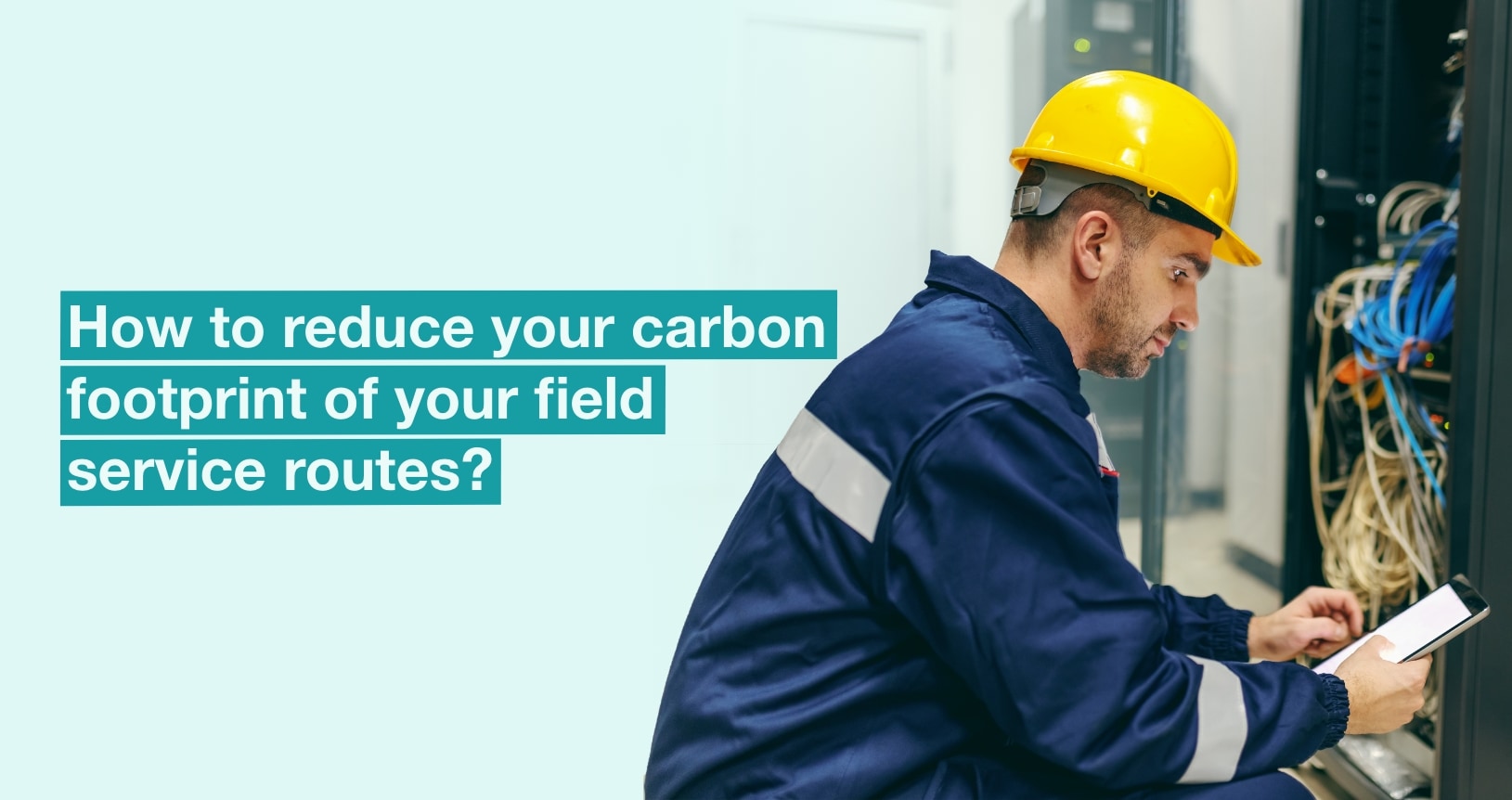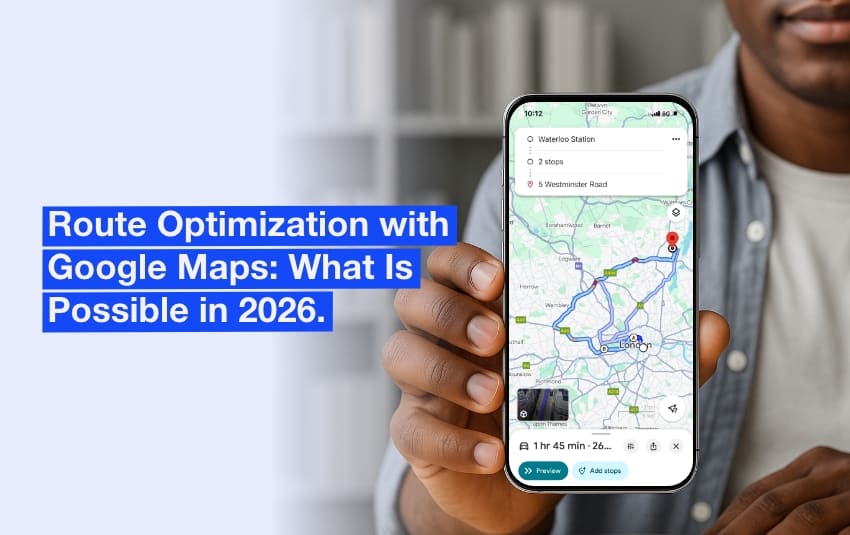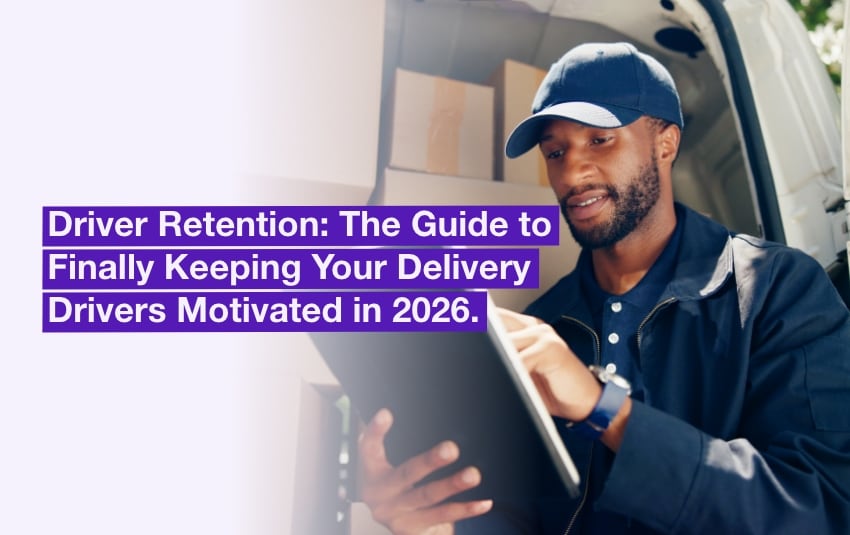Eco-responsible field service route management: how to reduce your carbon footprint?
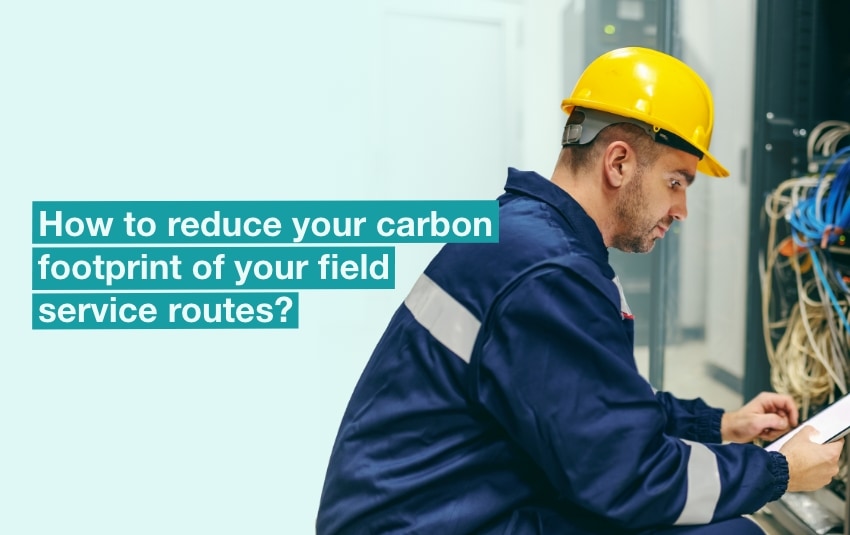
Blog > Field Service > Eco-responsible field service route management: how to reduce your carbon footprint?
Eco-responsible field service route management: how to reduce your carbon footprint?
Published on 28 June 2021 • Reading time: 6 min read
Facing the global warming, more and more consumers expect companies to make commitments in terms of Social and Environmental Responsibility. But greenhouse gases due to road transport alone accounted for 28% of all CO2 emissions in 2019! In this challenging context, carriers, but also all services that require mobile teams, are encouraged to implement sustainable mobility policies: breakdown services, mobile technicians, home service providers, etc.
Here are the ways to reduce the carbon footprint of your field service routes.
Table of contents
- Limit the number of miles travelled
- Reduce the carbon footprint linked to route management
- Reduce the carbon footprint of the vehicle fleet
Due to the climate challenge, reducing the carbon footprint of field service routes is crucial. Software solutions can be used to limit the number of kilometres travelled by technicians in the field. Another option is to make the vehicle fleet carbon-free.
Limit the number of miles travelled
The zero waste trend has made popular the idea that the best waste is the one you don’t produce. In the same way, route management software considers that the best mileage is the one you don’t run.
Today, companies can rely on algorithms and artificial intelligence to reduce the number of miles travelled by field workers as much as possible.
Recalculate routes in real time
The traffic jams not only cause stress and tiredness for the employees, but also have an important environmental cost. A vehicle travelling on a busy highway generates 16 times more greenhouse gas emissions than in smooth traffic. In addition, it needs twice as much fuel!
The most interesting measure is therefore to give mobile teams a GPS, or even better, a route management software. In all cases, an onboard software calculates in real time the optimal route according to the traffic. The AntsRoute software natively integrates Google Maps or Waze.
In comparison to a standard GPS, route optimization software has another major advantage, since it recalculates the best route in the event of an unforeseen event. For example, if a customer cancels an operation scheduled for the day, the software reoptimizes the route in real time, without having to re-enter all the addresses. In the same way, if a technician is sick or his vehicle breaks down, the operations manager can reassign all or part of his appointments to other workers. The new routes are recalculated remotely, without having to come back to the office to get the new route.
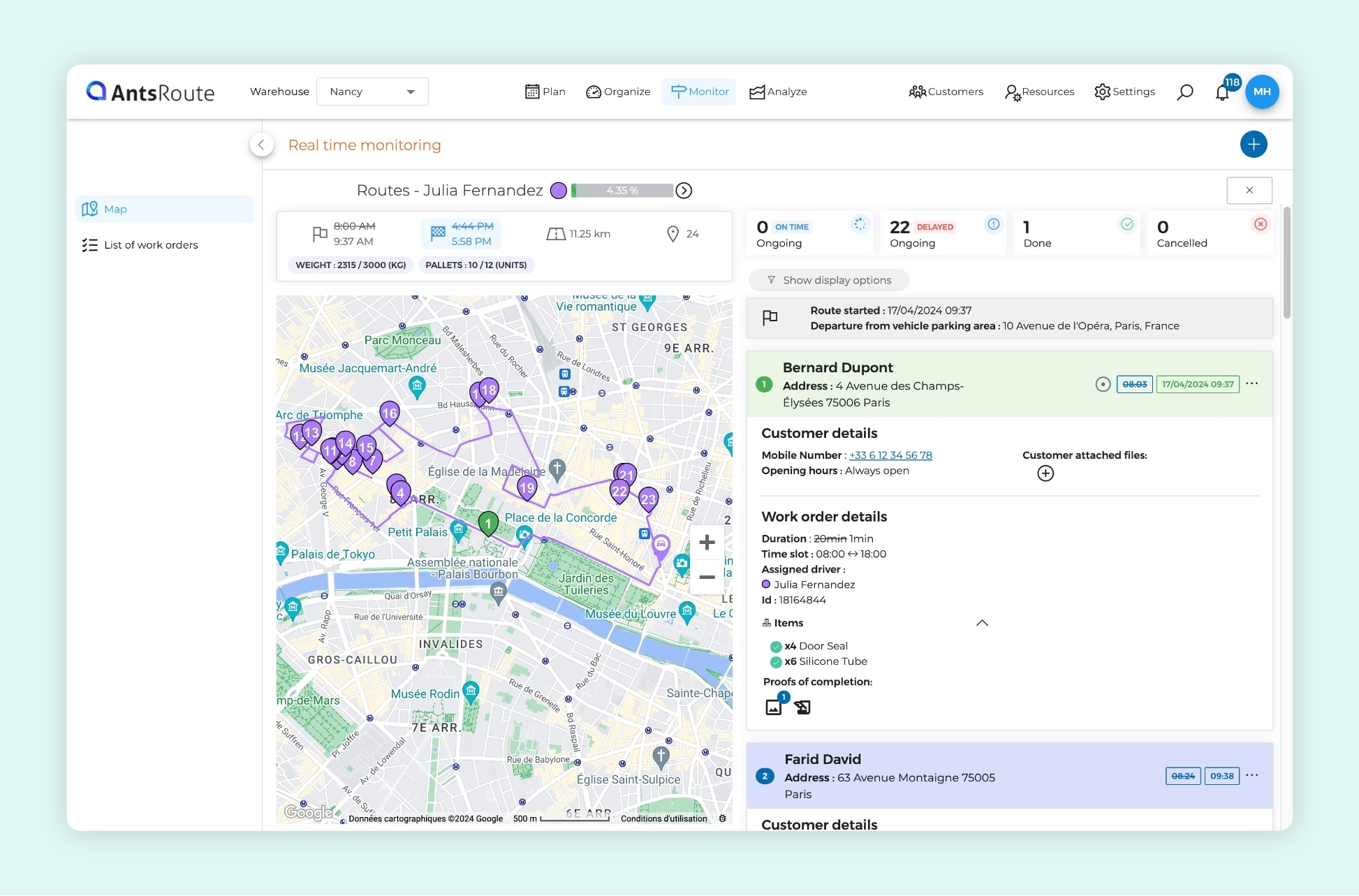
Live tracking of a field service route on AntsRoute.
Optimize the field service routes according to the address of your workers
To reduce unnecessary miles, route optimization software can also be used to assign a specific geographic area to a technician, or to optimize routes based on a predefined address.
If a technician lives in the area where he usually works, you can schedule his routes according to his home address. Also, if the field worker already has the necessary equipment in his vehicle, this avoids an unnecessary detour to the company’s facilities.
Maximize vehicle loading
Some industries require one or more trips to warehouses or storage locations, to pick up spare parts for example. To optimize routes while integrating these constraints, the AntsRoute software includes a specific mode, pick up and delivery.
Depending on your business, another option is to optimize the space available in the different vehicles by setting the maximum load capacity of each model.
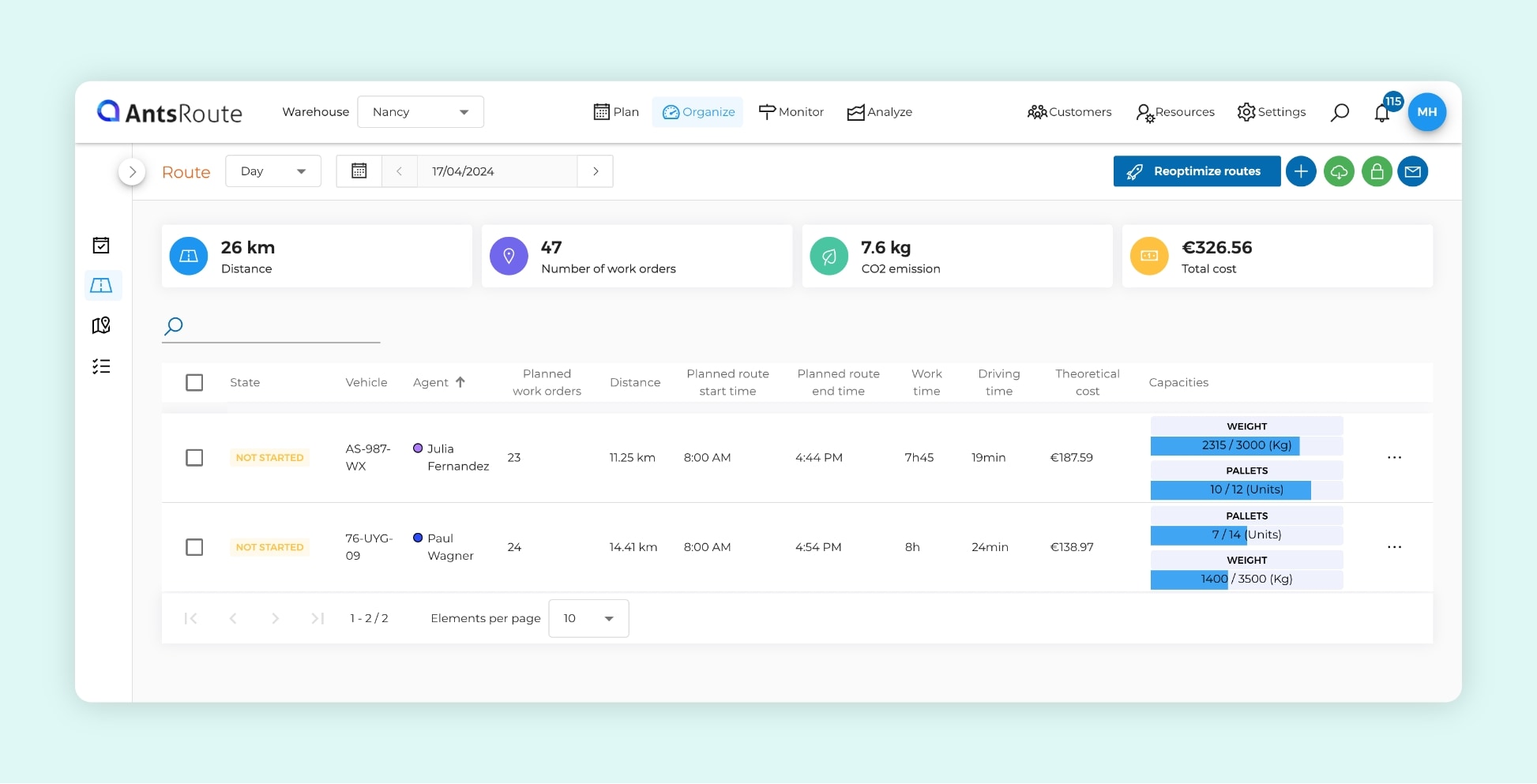
Maximising the loading rate of vehicles on AntsRoute.
Reduce the carbon footprint linked to route management
By using route optimization software, your company is taking a step towards “paperless”. If the forest says thank you, the ecological footprint of digital technology should not be forgotten. In order to make this digital transition as positive as possible, a few simple measures can be implemented.
Increase the life cycle of electronic devices
Did you know that it takes 240 kg of fossil fuels, 22 kg of chemicals and 1.5 tons of water to manufacture one computer? In order to limit the impact of these CO2 emission factors, your teams should keep their business tablets and other smartphones as long as possible.
Fortunately, the route optimization software available on the market all operate in SaaS (Software as a Service) mode. In other words, all the computer calculations required to optimize routes are performed remotely, on a shared cloud infrastructure managed by the publisher. The huge advantage of this system is that the application “runs” very well, even on older terminals, since the “brain” of the software is located elsewhere.
Another good idea is to recycle all that digital equipment when it actually reaches the end of its life. To be honest, this usually happens well after their accounting depreciation has expired…
Encourage remote working for support functions
In recent months, telecommuting has been developing quickly, mainly for health reasons. But this way of working also has real benefits for the environment, starting with the reduction of CO2 emissions linked to home-work journeys.
With a growing number of software applications operating in SaaS mode, employees in charge of route management can easily telecommute, either part-time or full-time. With a cloud-hosted ERP like AntsRoute, they can plan and manage operations from any device, personal or professional, in complete security. Since no data is stored on the desktops, switching between devices is easy and eliminates the risk of lost or stolen data.

The use of suitable software simplifies the planning of field service operations.
Reduce the carbon footprint of the vehicle fleet
The last method, which is very efficient but not always easy to apply, consists in progressively reducing the greenhouse gases caused by vehicles. Well aware of the obstacles that can slow down the implementation of this low-carbon strategy, our teams have created truly operational solutions, which were rewarded by the French magazine l’Automobile et l’Entreprise in the sustainable development category.
Optimize routes according to the type of vehicle
With our route optimization software, you can precisely organize your routes according to the type of vehicle used. To improve your environmental performance, AntsRoute takes into account multiple data:
- Automatic display of CO2 emissions to be included in your carbon footprint.
- Calculation of energy consumption per task.
- Presence of charging stations in the working area, etc.
Our software integrates all types of alternative motorizations: electric cars, hybrids, natural gas, electrically assisted bikes, etc.
For example, you can set the maximum autonomy for each electric vehicle, in order to optimize the field service routes according to the stops necessary for recharging. Each technician can also view the remaining battery range on the application before the next recharge.
To further reduce CO2 emissions, you can even ask the software to prioritize the most environmentally friendly vehicles for service routes.
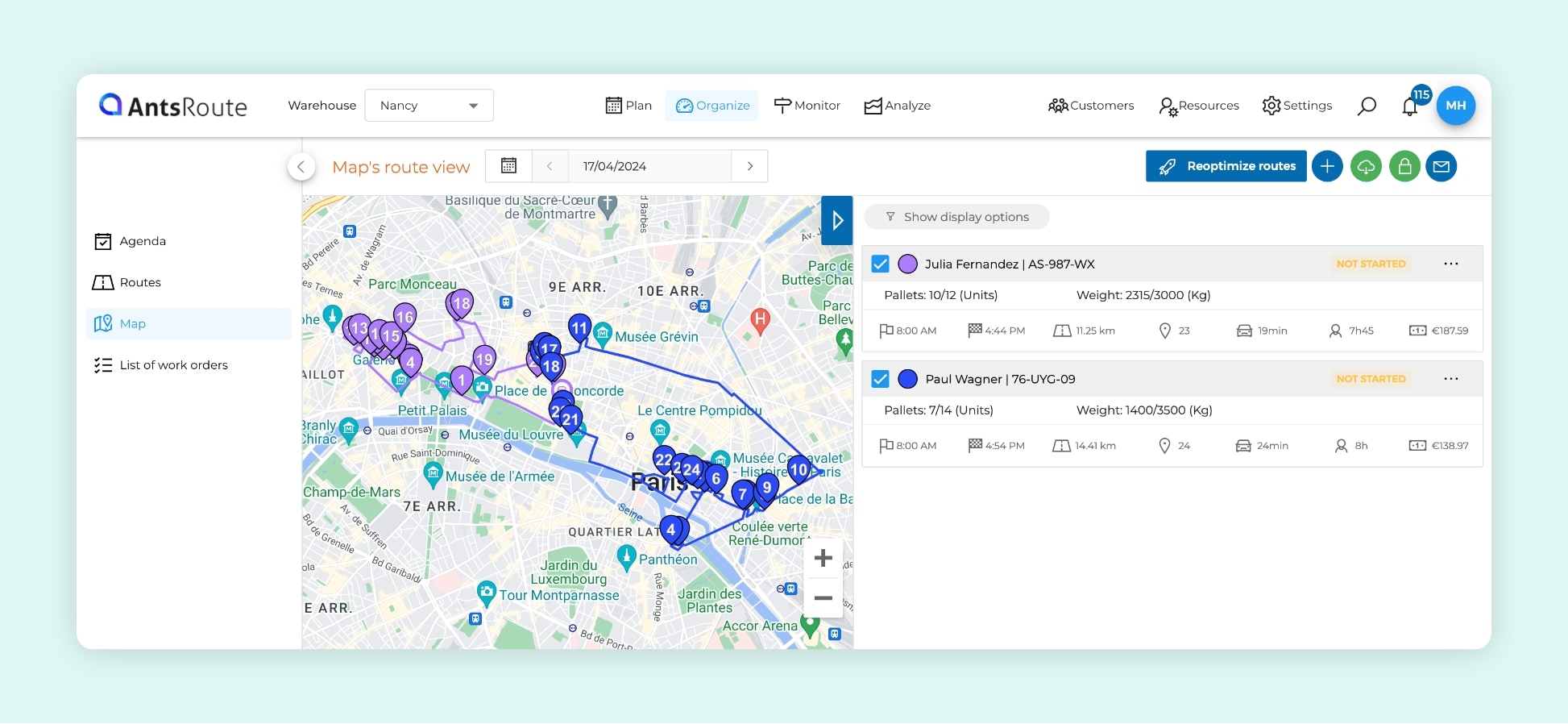
The optimization of routes using AntsRoute software.
Encourage the shift to an eco-responsible management of field service routes
Having support on a daily basis, your teams are less worried about alternative modes of transport that run on renewable energy. The psychological and logistical barriers are gradually disappearing, encouraging the progressive replacement of thermal vehicles by their low-emission alternatives.
To optimize your routes and reduce the carbon footprint of the field service routes, we offer you a free 7-day trial of our software. Go to this page to sign up!
Free 7-day trial | No credit card required
Contenu
- Limit the number of miles travelled
- Recalculate routes in real time
- Optimize the field service routes according to the address of your workers
- Maximize vehicle loading
- Reduce the carbon footprint linked to route management
- Increase the life cycle of electronic devices
- Encourage remote working for support functions
- Reduce the carbon footprint of the vehicle fleet
- Optimize routes according to the type of vehicle
- Encourage the shift to an eco-responsible management of field service routes


